手势识别OpenCV
- 格式:pdf
- 大小:3.55 MB
- 文档页数:8
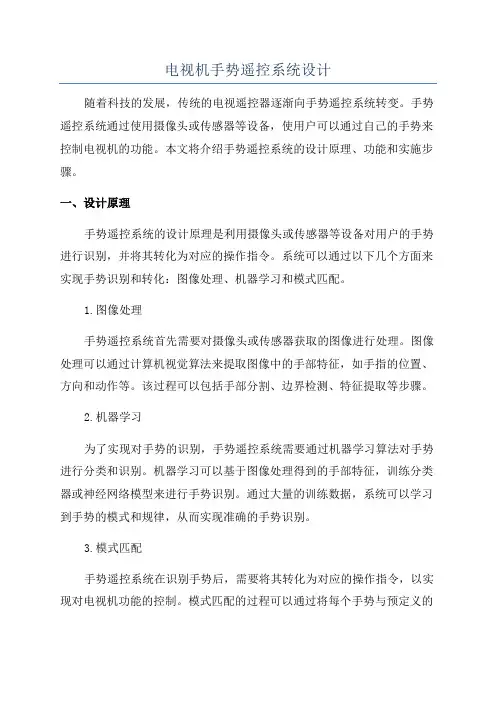
电视机手势遥控系统设计随着科技的发展,传统的电视遥控器逐渐向手势遥控系统转变。
手势遥控系统通过使用摄像头或传感器等设备,使用户可以通过自己的手势来控制电视机的功能。
本文将介绍手势遥控系统的设计原理、功能和实施步骤。
一、设计原理手势遥控系统的设计原理是利用摄像头或传感器等设备对用户的手势进行识别,并将其转化为对应的操作指令。
系统可以通过以下几个方面来实现手势识别和转化:图像处理、机器学习和模式匹配。
1.图像处理手势遥控系统首先需要对摄像头或传感器获取的图像进行处理。
图像处理可以通过计算机视觉算法来提取图像中的手部特征,如手指的位置、方向和动作等。
该过程可以包括手部分割、边界检测、特征提取等步骤。
2.机器学习为了实现对手势的识别,手势遥控系统需要通过机器学习算法对手势进行分类和识别。
机器学习可以基于图像处理得到的手部特征,训练分类器或神经网络模型来进行手势识别。
通过大量的训练数据,系统可以学习到手势的模式和规律,从而实现准确的手势识别。
3.模式匹配手势遥控系统在识别手势后,需要将其转化为对应的操作指令,以实现对电视机功能的控制。
模式匹配的过程可以通过将每个手势与预定义的操作指令进行匹配,从而确定所需的操作。
用户可以事先定义手势与操作的映射关系,或者系统通过学习和自适应的方式来建立映射关系。
二、功能手势遥控系统可以实现多种功能,常见的包括:1.频道切换:通过手势识别用户的左右滑动动作,实现电视机频道的切换。
2.音量调整:通过手势识别用户的上下滑动动作,实现电视机音量的调整。
3.菜单操作:通过手势识别用户的点击或拖动动作,实现电视机菜单的操作,如选择、确定等。
4.互动游戏:手势遥控系统还可以实现一些互动性质的游戏,用户可以通过手势来控制游戏中的角色或操作。
三、实施步骤实施手势遥控系统的步骤可以概括为以下几个方面:1.硬件选择:选择适合手势识别的传感器设备或摄像头,可以根据实际需求选用合适的型号和性能。
2.系统设计:设计手势识别算法和模型,包括图像处理、机器学习和模式匹配等步骤。
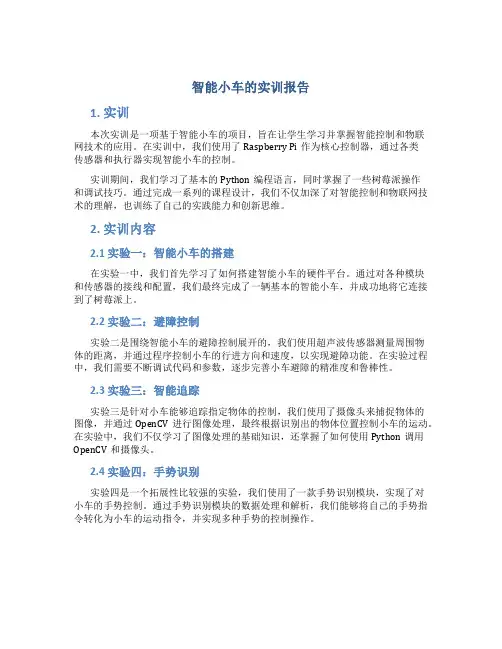
智能小车的实训报告1. 实训本次实训是一项基于智能小车的项目,旨在让学生学习并掌握智能控制和物联网技术的应用。
在实训中,我们使用了Raspberry Pi作为核心控制器,通过各类传感器和执行器实现智能小车的控制。
实训期间,我们学习了基本的Python编程语言,同时掌握了一些树莓派操作和调试技巧。
通过完成一系列的课程设计,我们不仅加深了对智能控制和物联网技术的理解,也训练了自己的实践能力和创新思维。
2. 实训内容2.1 实验一:智能小车的搭建在实验一中,我们首先学习了如何搭建智能小车的硬件平台。
通过对各种模块和传感器的接线和配置,我们最终完成了一辆基本的智能小车,并成功地将它连接到了树莓派上。
2.2 实验二:避障控制实验二是围绕智能小车的避障控制展开的,我们使用超声波传感器测量周围物体的距离,并通过程序控制小车的行进方向和速度,以实现避障功能。
在实验过程中,我们需要不断调试代码和参数,逐步完善小车避障的精准度和鲁棒性。
2.3 实验三:智能追踪实验三是针对小车能够追踪指定物体的控制,我们使用了摄像头来捕捉物体的图像,并通过OpenCV进行图像处理,最终根据识别出的物体位置控制小车的运动。
在实验中,我们不仅学习了图像处理的基础知识,还掌握了如何使用Python调用OpenCV和摄像头。
2.4 实验四:手势识别实验四是一个拓展性比较强的实验,我们使用了一款手势识别模块,实现了对小车的手势控制。
通过手势识别模块的数据处理和解析,我们能够将自己的手势指令转化为小车的运动指令,并实现多种手势的控制操作。
3. 实训收获通过本次实训,我们不仅学到了很多智能控制和物联网技术的应用知识,还锻炼了自己的实践能力和团队协作能力。
在实验过程中,我们需要不断调试和优化代码,同时也需要和同学合作,互相帮助和交流。
除此之外,我们还学到了如何独立思考和创新,不仅是在完成课程设计时,也体现在我们对未来的探索和思考上。
这是一次非常有意义的实训,让我们受益匪浅。
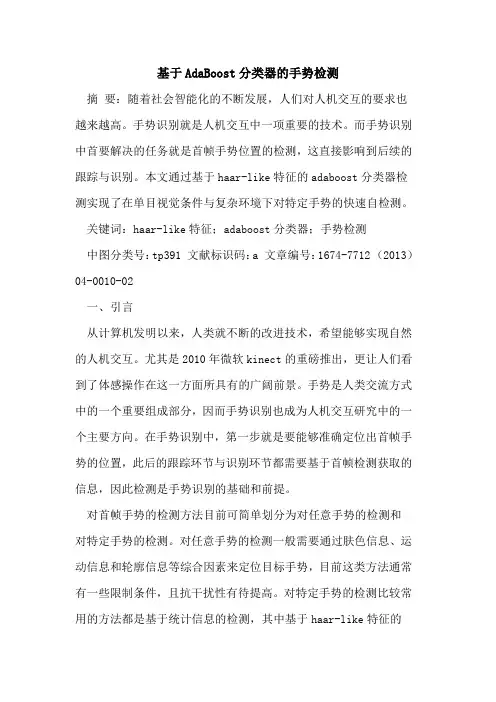
基于AdaBoost分类器的手势检测摘要:随着社会智能化的不断发展,人们对人机交互的要求也越来越高。
手势识别就是人机交互中一项重要的技术。
而手势识别中首要解决的任务就是首帧手势位置的检测,这直接影响到后续的跟踪与识别。
本文通过基于haar-like特征的adaboost分类器检测实现了在单目视觉条件与复杂环境下对特定手势的快速自检测。
关键词:haar-like特征;adaboost分类器;手势检测中图分类号:tp391 文献标识码:a 文章编号:1674-7712 (2013)04-0010-02一、引言从计算机发明以来,人类就不断的改进技术,希望能够实现自然的人机交互。
尤其是2010年微软kinect的重磅推出,更让人们看到了体感操作在这一方面所具有的广阔前景。
手势是人类交流方式中的一个重要组成部分,因而手势识别也成为人机交互研究中的一个主要方向。
在手势识别中,第一步就是要能够准确定位出首帧手势的位置,此后的跟踪环节与识别环节都需要基于首帧检测获取的信息,因此检测是手势识别的基础和前提。
对首帧手势的检测方法目前可简单划分为对任意手势的检测和对特定手势的检测。
对任意手势的检测一般需要通过肤色信息、运动信息和轮廓信息等综合因素来定位目标手势,目前这类方法通常有一些限制条件,且抗干扰性有待提高。
对特定手势的检测比较常用的方法都是基于统计信息的检测,其中基于haar-like特征的adaboost分类器就是一种普遍使用的方案,这也是本文所采用的方法。
二、基于haar-like特征的adaboost手势检测haar-like特征haar-like特征是计算机视觉领域一种常用的特征描述算子,它最早是由papageorigiou[1]等人提出的。
目前常用的haar-like特征可以分为三类:线性特征、边缘特征和中心特征。
每一种特征的计算都是由黑色填充区域的像素值之和与白色填充区域的像素值之和的差值。
而计算出来的这个差值就是所谓的haar-like特征的特征值。
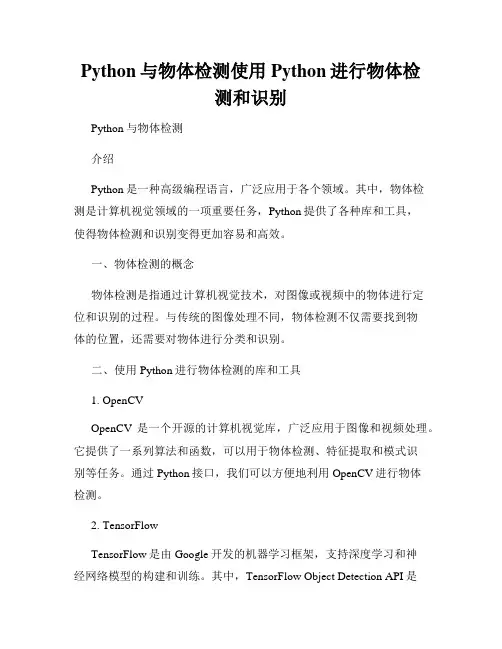
Python与物体检测使用Python进行物体检测和识别Python与物体检测介绍Python是一种高级编程语言,广泛应用于各个领域。
其中,物体检测是计算机视觉领域的一项重要任务,Python提供了各种库和工具,使得物体检测和识别变得更加容易和高效。
一、物体检测的概念物体检测是指通过计算机视觉技术,对图像或视频中的物体进行定位和识别的过程。
与传统的图像处理不同,物体检测不仅需要找到物体的位置,还需要对物体进行分类和识别。
二、使用Python进行物体检测的库和工具1. OpenCVOpenCV是一个开源的计算机视觉库,广泛应用于图像和视频处理。
它提供了一系列算法和函数,可以用于物体检测、特征提取和模式识别等任务。
通过Python接口,我们可以方便地利用OpenCV进行物体检测。
2. TensorFlowTensorFlow是由Google开发的机器学习框架,支持深度学习和神经网络模型的构建和训练。
其中,TensorFlow Object Detection API是一个流行的物体检测框架,基于深度学习算法,并提供了预训练的模型和方便的API接口,可以用于快速构建物体检测系统。
3. PyTorchPyTorch是另一个流行的深度学习框架,也支持物体检测和识别任务。
类似于TensorFlow,PyTorch提供了一些预训练的物体检测模型和优化算法,方便用户快速搭建和训练自己的物体检测模型。
三、Python物体检测的步骤1. 数据收集和准备物体检测需要大量的标注样本数据,用于训练和测试模型。
在Python中,可以利用各种图像处理库和工具,对数据进行预处理和增强,以提高物体检测的准确性和鲁棒性。
2. 模型选择和训练根据实际需求,选择适合的物体检测模型。
可以使用已经预训练好的模型,也可以自己构建和训练模型。
使用Python提供的深度学习框架,可以方便地构建、训练和评估物体检测模型。
3. 物体检测和识别利用训练好的模型进行物体检测和识别。
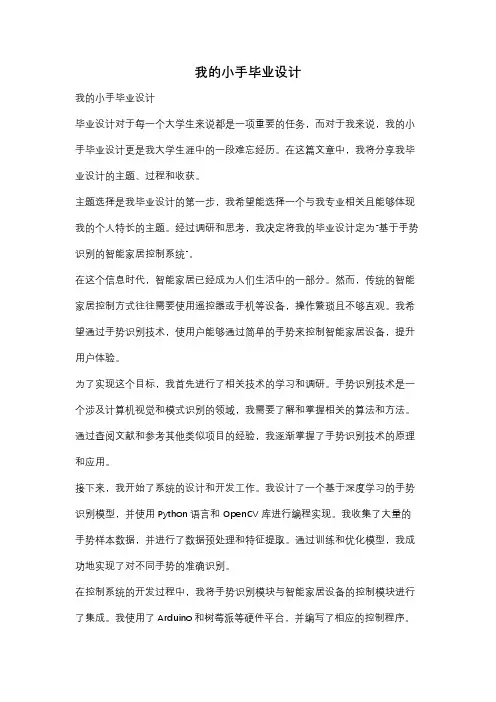
我的小手毕业设计我的小手毕业设计毕业设计对于每一个大学生来说都是一项重要的任务,而对于我来说,我的小手毕业设计更是我大学生涯中的一段难忘经历。
在这篇文章中,我将分享我毕业设计的主题、过程和收获。
主题选择是我毕业设计的第一步,我希望能选择一个与我专业相关且能够体现我的个人特长的主题。
经过调研和思考,我决定将我的毕业设计定为“基于手势识别的智能家居控制系统”。
在这个信息时代,智能家居已经成为人们生活中的一部分。
然而,传统的智能家居控制方式往往需要使用遥控器或手机等设备,操作繁琐且不够直观。
我希望通过手势识别技术,使用户能够通过简单的手势来控制智能家居设备,提升用户体验。
为了实现这个目标,我首先进行了相关技术的学习和调研。
手势识别技术是一个涉及计算机视觉和模式识别的领域,我需要了解和掌握相关的算法和方法。
通过查阅文献和参考其他类似项目的经验,我逐渐掌握了手势识别技术的原理和应用。
接下来,我开始了系统的设计和开发工作。
我设计了一个基于深度学习的手势识别模型,并使用Python语言和OpenCV库进行编程实现。
我收集了大量的手势样本数据,并进行了数据预处理和特征提取。
通过训练和优化模型,我成功地实现了对不同手势的准确识别。
在控制系统的开发过程中,我将手势识别模块与智能家居设备的控制模块进行了集成。
我使用了Arduino和树莓派等硬件平台,并编写了相应的控制程序。
通过与智能家居设备的通信,我实现了通过手势来控制灯光、温度等功能。
在整个过程中,我遇到了许多挑战和困难。
手势识别算法的优化、硬件设备的调试以及系统的稳定性等问题都需要我不断思考和解决。
但正是这些困难,让我更加深入地理解了所学知识,并提升了我的技术能力和解决问题的能力。
最终,我完成了我的小手毕业设计,并进行了实验和测试。
通过与其他同学和教师的交流和反馈,我得到了许多宝贵的意见和建议。
我对自己的成果感到满意,同时也意识到了自己在设计和实现过程中的不足之处。
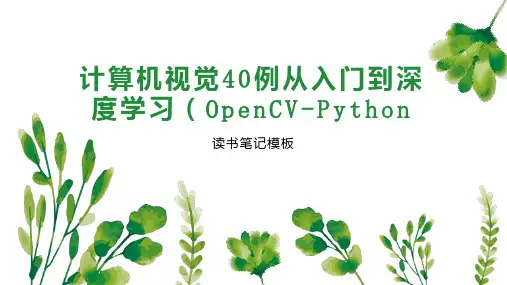
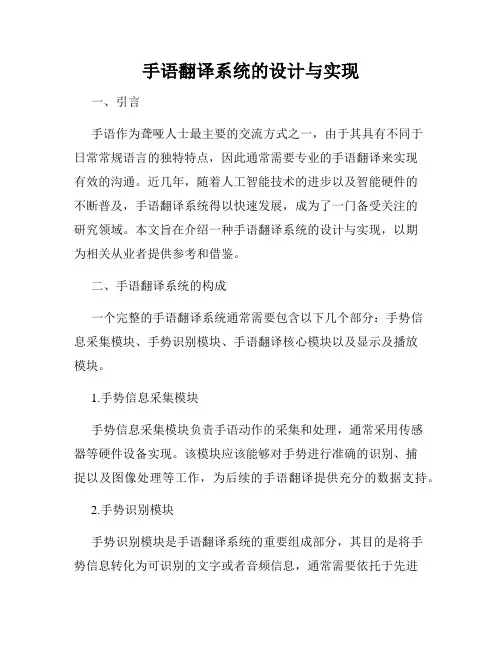
手语翻译系统的设计与实现一、引言手语作为聋哑人士最主要的交流方式之一,由于其具有不同于日常常规语言的独特特点,因此通常需要专业的手语翻译来实现有效的沟通。
近几年,随着人工智能技术的进步以及智能硬件的不断普及,手语翻译系统得以快速发展,成为了一门备受关注的研究领域。
本文旨在介绍一种手语翻译系统的设计与实现,以期为相关从业者提供参考和借鉴。
二、手语翻译系统的构成一个完整的手语翻译系统通常需要包含以下几个部分:手势信息采集模块、手势识别模块、手语翻译核心模块以及显示及播放模块。
1.手势信息采集模块手势信息采集模块负责手语动作的采集和处理,通常采用传感器等硬件设备实现。
该模块应该能够对手势进行准确的识别、捕捉以及图像处理等工作,为后续的手语翻译提供充分的数据支持。
2.手势识别模块手势识别模块是手语翻译系统的重要组成部分,其目的是将手势信息转化为可识别的文字或者音频信息,通常需要依托于先进的智能图像识别技术和自然语言处理技术等来实现。
具体操作包括预处理手势图像、图像特征提取、特征匹配识别、语义理解等环节。
3.手语翻译核心模块手语翻译核心模块是整个系统的重点,其主要作用是将识别出的手语文字或音频信息进行翻译转换,将其转换为能够有效传达信息的目标语言。
为了实现这个目标,我们需要借助于大规模数据集和语音信号处理技术等资源,以尽可能提高翻译质量和准确度。
4.显示及播放模块显示及播放模块负责将翻译后的信息展示出来,可以通过LCD 屏幕、扩音器、互联网平台等方式进行传播。
该模块的功能包括语音合成、文字显示、字幕生成、声音播放等操作。
三、手语翻译系统的实现手语翻译系统的实现需要结合上述几个方面的模块来协同工作,以达到优秀的效果。
以下,本文我们以国际通用手语语言ASL为例,介绍一下系统的具体实现流程。
1.手势信息采集手势信息采集部分通常基于深度学习技术,使用RGB-D摄像机采集手势信息,并使用OpenNI或Kinect SDK之类的软件对这些数据进行预处理。
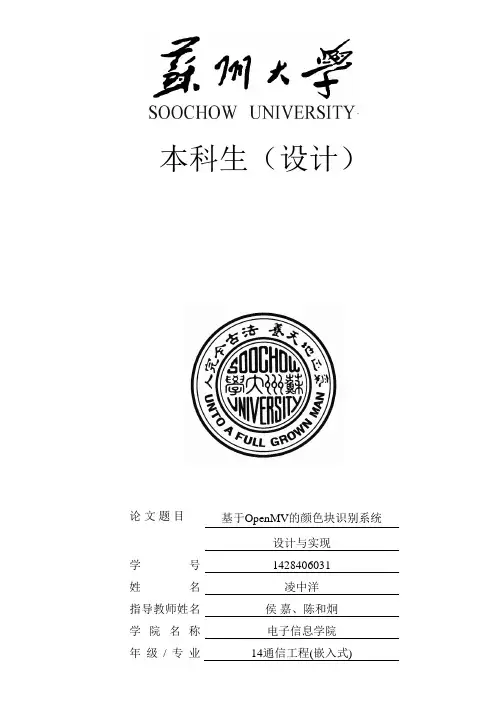
` 本科生(设计)论文题目基于OpenMV的颜色块识别系统设计与实现学号1428406031姓名凌中洋指导教师姓名侯嘉、陈和炯学院名称电子信息学院年级/专业14通信工程(嵌入式)论文提交日期2018年5月130 日目录摘要 (1)Abstract (2)前言 (3)第一章绪论 (5)1.1 研究背景 (5)1.2 国内外现状 (5)1.3 本文主要研究内容 (6)第二章 OpenMV颜色块识别系统设计的分析 (8)2.1 颜色块识别与追踪系统的分析与原理 (8)2.2 颜色块测距系统的分析与原理 (10)第三章 Python代码的编写 (12)3.1 Micro Python语言简介 (12)3.2 识别与追踪系统流程图与代码编写 (12)3.3 测距系统流程图与代码编写 (17)第四章系统的实现与误差比较 (20)4.1 颜色块识别与追踪系统的实现 (20)4.2 颜色块测距系统的实现 (25)第五章总结与展望 (30)5.1 课题总结 (30)5.2 研究展望 (30)参考文献 (31)致谢 (34)摘要作为机器视觉模块的重要技术之一的OpenMV (Open Machine vision)开放视觉模块,是当下嵌入式计算机视觉领域的一个研究热点。
OpenMV视觉模块对于颜色块识别、追踪与测距系统的实现,在背景颜色与目标颜色相近程度、光照强度、颜色块与镜头的距离发生改变时,都会对测试结果产生较大的影响。
因此分析这些改变时对我所设计的OpenMV颜色块识别追踪与测距系统产生的影响是有必要的。
本文主要的工作内容是:首先研究分析OpenMV的颜色块识别与测距系统模型的设计,然后研究了OpenMV视觉模块的基本原理和MicroPython语言的编写,接着对背景颜色与目标颜色的相近程度和颜色块与镜头距离改变时系统的误差做了比较与说明,最终完成了1)基于OpenMV的颜色块识别与追踪系统设计;2)颜色块目标测距系统的设计。
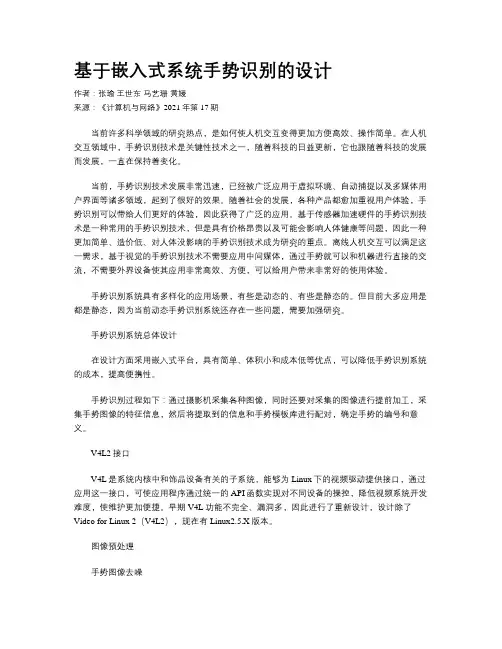
基于嵌入式系统手势识别的设计作者:张瑜王世东马艺珊黄嫒来源:《计算机与网络》2021年第17期当前许多科学领域的研究热点,是如何使人机交互变得更加方便高效、操作简单。
在人机交互领域中,手势识别技术是关键性技术之一,随着科技的日益更新,它也跟随着科技的发展而发展,一直在保持着变化。
当前,手势识别技术发展非常迅速,已经被广泛应用于虚拟环境、自动捕捉以及多媒体用户界面等诸多领域,起到了很好的效果。
随着社会的发展,各种产品都愈加重视用户体验,手势识别可以带给人们更好的体验,因此获得了广泛的应用。
基于传感器加速硬件的手势识别技术是一种常用的手势识别技术,但是具有价格昂贵以及可能会影响人体健康等问题,因此一种更加简单、造价低、对人体没影响的手势识别技术成为研究的重点。
离线人机交互可以满足这一需求,基于视觉的手势识别技术不需要应用中间媒体,通过手势就可以和机器进行直接的交流,不需要外界设备使其应用非常高效、方便,可以给用户带来非常好的使用体验。
手势识别系统具有多样化的应用场景,有些是动态的、有些是静态的。
但目前大多应用是都是静态,因为当前动态手势识别系统还存在一些问题,需要加强研究。
手势识别系统总体设计在设计方面采用嵌入式平台,具有简单、体积小和成本低等优点,可以降低手势识别系统的成本,提高便携性。
手势识别过程如下:通过摄影机采集各种图像,同时还要对采集的图像进行提前加工,采集手势图像的特征信息,然后将提取到的信息和手势模板库进行配对,确定手势的编号和意义。
V4L2接口V4L是系统内核中和饰品设备有关的子系统,能够为Linux下的视频驱动提供接口,通过应用这一接口,可使应用程序通过统一的API函数实现对不同设备的操控,降低视频系统开发难度,使维护更加便捷。
早期V4L功能不完全、漏洞多,因此进行了重新设计,设计除了Video for Linux 2(V4L2),现在有Linux2.5.X版本。
图像预处理手势图像去噪在进行动作视频的收集时,系统可能是移动的,因此获得的手势图像不可避免地会受到干扰,包括外部环境光强度的变化和相机抖动,会造成获取的对象和信息库中的图像存在差异,因此需要对收集到的手势图像进行降噪处理,从而更加准确地进行识别,提高图像识别率。
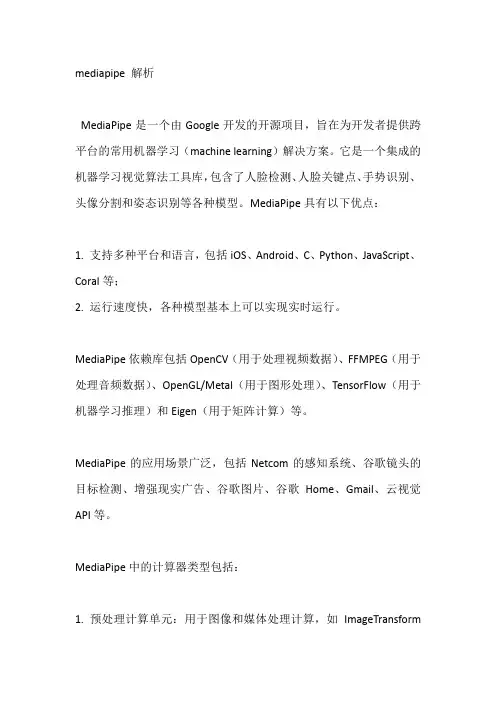
mediapipe 解析MediaPipe是一个由Google开发的开源项目,旨在为开发者提供跨平台的常用机器学习(machine learning)解决方案。
它是一个集成的机器学习视觉算法工具库,包含了人脸检测、人脸关键点、手势识别、头像分割和姿态识别等各种模型。
MediaPipe具有以下优点:1. 支持多种平台和语言,包括iOS、Android、C、Python、JavaScript、Coral等;2. 运行速度快,各种模型基本上可以实现实时运行。
MediaPipe依赖库包括OpenCV(用于处理视频数据)、FFMPEG(用于处理音频数据)、OpenGL/Metal(用于图形处理)、TensorFlow(用于机器学习推理)和Eigen(用于矩阵计算)等。
MediaPipe的应用场景广泛,包括Netcom的感知系统、谷歌镜头的目标检测、增强现实广告、谷歌图片、谷歌Home、Gmail、云视觉API等。
MediaPipe中的计算器类型包括:1. 预处理计算单元:用于图像和媒体处理计算,如ImageTransform和imagetotensor;2. 推理计算单元:允许与TensorFlow和TensorFlow Lite进行ML推理的本地集成;3. 后处理计算单元:执行ML后处理任务,如检测、分割和分类,如TensorToLandmark;4. 计算单元工具:执行特定任务的一类计算单元。
MediaPipe提供了16个开源预构建示例(Solutions),包括人脸检测、Face Mesh(面网)、虹膜识别、手势识别、姿态识别、人体分割、头发分割、目标检测、Box Tracking(方格追踪)、Instant Motion Tracking (实时运动跟踪)、3D目标检测、特征匹配、AutoFlip(视频裁剪)、MediaSequence(媒体序列)和YouTube-8M(视频标签比赛)。
MediaPipe的框架结构包括计算图(Calculator Graph)、计算图配置(Calculator Graph Config)、计算器(Calculator)、数据流(Data Flow)、节点(Node)和图(Graph)等概念。
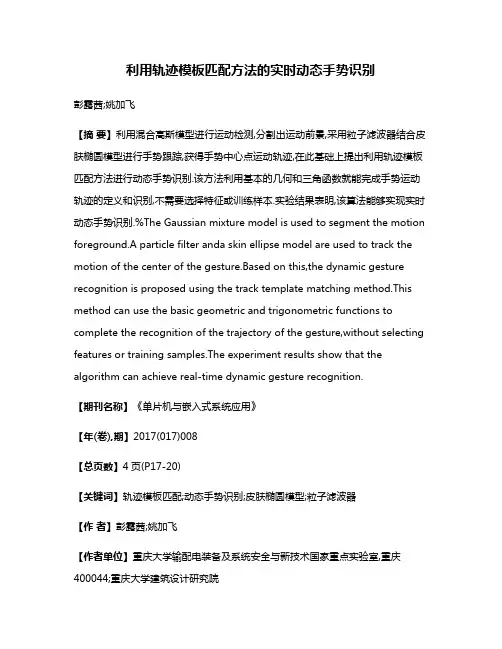
利用轨迹模板匹配方法的实时动态手势识别彭露茜;姚加飞【摘要】利用混合高斯模型进行运动检测,分割出运动前景,采用粒子滤波器结合皮肤椭圆模型进行手势跟踪,获得手势中心点运动轨迹,在此基础上提出利用轨迹模板匹配方法进行动态手势识别.该方法利用基本的几何和三角函数就能完成手势运动轨迹的定义和识别,不需要选择特征或训练样本.实验结果表明,该算法能够实现实时动态手势识别.%The Gaussian mixture model is used to segment the motion foreground.A particle filter anda skin ellipse model are used to track the motion of the center of the gesture.Based on this,the dynamic gesture recognition is proposed using the track template matching method.This method can use the basic geometric and trigonometric functions to complete the recognition of the trajectory of the gesture,without selecting features or training samples.The experiment results show that the algorithm can achieve real-time dynamic gesture recognition.【期刊名称】《单片机与嵌入式系统应用》【年(卷),期】2017(017)008【总页数】4页(P17-20)【关键词】轨迹模板匹配;动态手势识别;皮肤椭圆模型;粒子滤波器【作者】彭露茜;姚加飞【作者单位】重庆大学输配电装备及系统安全与新技术国家重点实验室,重庆400044;重庆大学建筑设计研究院【正文语种】中文【中图分类】TP391.4手势识别作为新型人机交互方式之一,成为一项越来越重要的热点研究内容。
基于Kinect的指尖检测与手势识别方法作者:谈家谱徐文胜来源:《计算机应用》2015年第06期摘要:针对基于视频的弯曲指尖点识别难、识别率不高的问题,提出一种基于深度信息、骨骼信息和彩色信息的手势识别方法。
该方法首先利用Kinect相机的深度信息和骨骼信息初步快速判定手势在彩色图像中所在的区域,在该区域运用YCrCb肤色模型分割出手势区域;然后计算手势轮廓点到掌心点的距离并生成距离曲线,设定曲线波峰与波谷的比值参数来判定指尖点;最后结合弯曲指尖点特征和最大内轮廓面积特征识别出常用的12个手势。
实验结果验证阶段邀请了6位实验者在相对稳定的光照环境条件下来验证提出的方法,每个手势被实验120次,12种手势的平均识别率达到了97.92%。
实验结果表明,该方法能快速定位手势并准确地识别出常用的12种手势,且识别率较高。
关键词:Kinect;肤色模型;开源计算机视觉库;指尖检测;手势识别中图分类号: TP391.41 文献标志码:A英文摘要Abstract:The recognition of bending finger points based on video is difficult and recognition rate is not high. Focusing on the issue, a hand gesture recognition method based on depth image,skeleton image and color image information was proposed. Firstly, the gesture in color image area was initially determined rapidly by using depth information and skeleton information of Kinect, and the hand posture region was extracted from the gesture area by using the YCrCb color model. Then the distances between the gesture contour points and the palm point were calculated to generate the distance curve, and the ratio of curve peaks to troughs was set up to obtain finger point. Finally,commonly used 12 gestures were identified by combining bending finger point features and the maximum amount of contour area. Six experimenters were invited to validate the proposed method in experimental results verification phase. Every gesture was experimented 120 times under the condition of relatively stable light environment and the recognition rate of 12 gestures was 97.92% on average. The experimental results show that the proposed method can quickly location gestures and accurately recognize the commonly used 12 kinds of hand gestures, and the recognition rate is high.英文关键词Key words:Kinect; skin color model; Open Source Computer Vision Library (OPENCV); finger detection; gesture recognition0 引言随着计算机视觉的发展,基于视觉的手势识别方法已成为人机交互领域的研究热点[1]。
基于图像识别和手势跟踪的透射式智能眼镜(上)王子川【摘要】智能眼镜正在逐渐成为可穿戴设备领域里的重要研究方向,而市场上现有的产品大多存在操作繁琐、增强现实体验不好等问题.在对市场及实际应用的诸多种智能眼镜分析研究的基础上,进一步研究增强现实体验更好、操控更为人性化的智能眼镜具有重要的现实意义.在输入方面,本研究提出的基于计算机视觉的手势跟踪识别和透射式标定方法为智能眼镜的输入方式提供了一种新的解决方案,可以实现对于点击和滑动操作的检测;在增强现实方面,基于计算机视觉的透射式智能眼镜的增强现实算法为智能眼镜的增强现实应用提供了解决方法,可以实现三维物体的动态叠加.上述的跟踪识别、标定方法以及增强现实算法和硬件一同构成了增强现实智能眼镜系统.除此之外,本项目讨论了该系统未来在消费级和企业级市场的不同应用,实验中搭建的两版增强现实眼镜系统也为将来的实际应用做出了示范.整个系统的创新之处在于首次在将透射式智能眼镜上利用标定实现基于自然特征点的三维动态增强现实与利用新的方法在智能眼镜上实现对手指的跟踪识别,因而相比其他的同类产品,该系统拥有操控简便、增强现实效果好的优点.【期刊名称】《家电科技》【年(卷),期】2015(000)006【总页数】3页(P26-28)【关键词】智能眼镜;计算机视觉;增强现实;手势跟踪识别;OSTHMD(光学透射式头戴显示器)【作者】王子川【作者单位】北京师范大学附属实验中学【正文语种】中文随着近年来可穿戴设备渐渐进入人们的视野,基于增强现实的智能眼镜开始成为业界研究的一个重点。
增强现实是一种于20世纪90年代被Thomas P. Caudell和David W. Mizell提出的技术,其特征是将虚拟的信息叠加到现实场景中,以实现对现实的增强[1]。
近年来智能眼镜行业的发展使人们与增强现实之间的距离又近了一步,因为智能眼镜的发展使增强现实的便利应用成为可能。
在此之前,谷歌公司已经推出了一款面向智能手机平台的增强现实应用Ingress,但是由于用户在使用时必须手持手机,所以体验并不是十分理想[2]。
基于Leap Motion手语语音转换的设计与实现引言手语是一种通过手势和身体语言来表达语言的方式,通常被聋哑人群体使用。
虽然手语是一种流利的沟通方式,但它仍然存在一定的局限性,比如无法与非手语使用者进行直接的口头交流。
为了解决这个问题,本文将介绍一种基于Leap Motion技术的手语语音转换系统的设计与实现。
1. Leap Motion 技术介绍Leap Motion 是一种基于手势识别的交互技术,它通过感应手势的方式来实现用户与计算机之间的交互。
Leap Motion 设备可以精确地识别手指和手的运动,因此非常适合用于手势识别和手势交互的应用场景。
借助于Leap Motion 技术,我们可以实现诸如手势控制游戏、手势控制界面等功能。
2. 系统设计基于Leap Motion的手语语音转换系统主要由以下几个模块组成:手势识别模块、手语转文字模块、文字转语音模块。
2.1 手势识别模块手势识别模块是整个系统的核心模块,它负责将Leap Motion感应到的手势转换为计算机能够理解的数据。
在这个模块中,我们需要编写算法来对不同的手势进行识别,并将识别到的手势数据传递给下一个模块进行处理。
2.2 手语转文字模块手语转文字模块负责将手语转换为文字,这一过程涉及到手势的编码和解码。
我们需要将Leap Motion感应到的手势数据转换为一系列的编码,然后再通过编码和解码的过程将手语转换为文字信息。
文字转语音模块是整个系统的输出模块,它负责将转换得到的文字信息转换为语音。
在这个模块中,我们可以使用文本转语音的技术来实现,比如使用开源的TTS引擎进行语音合成。
3. 系统实现在实际的系统实现过程中,我们可以基于Leap Motion的SDK来开发我们的系统。
Leap Motion的SDK提供了丰富的API和示例代码,可以帮助我们快速地实现手势识别和手势交互的功能。
我们还可以结合其他的开源工具和库来实现手语转文字和文字转语音的功能,比如使用Python的OpenCV库进行手语识别,使用Google的TTS引擎进行语音合成等。
cascadeclassifier函数CascadeClassifier函数是计算机视觉中opencv库中的一个重要函数,它用于训练和检测基于Haar特征的目标检测模型。
Haar特征指的是人脸等图像特征的一种统计学特征,然后通过CascadeClassifier算法在该图像中对目标进行识别。
CascadeClassifier函数基于弱分类器和强分类器的思想。
弱分类器可以识别目标的一些基本特征,强分类器根据这些基本特征进行组合,并且最终输出判断置信度的结果。
CascadeClassifier算法使用AdaBoost (Adaptive Boosting)算法进行学习。
AdaBoost算法是一种集成算法,它将多个弱分类器组合成一个强分类器,从而提高识别率。
CascadeClassifier函数的使用方法如下:1. 初始化CascadeClassifier对象。
2.加载已经训练好的模型文件。
3.处理输入图像。
gray = cv2.cvtColor(img, cv2.COLOR_BGR2GRAY)。
4. 使用CascadeClassifier识别目标。
faces = cascade.detectMultiScale(gray, scaleFactor=1.3, minNeighbors=5, minSize=(30, 30))。
参数解释:scaleFactor:每次缩小图像的尺寸,通常为1.3,表示每次缩小30%。
minNeighbors:表示检测到目标周围的最小矩形数,通常为5。
minSize:表示将过小的矩形过滤掉,通常为(30,30)。
5.在图像中标记出目标位置。
for (某,y,w,h) in faces:。
cv2.rectangle(img,(某,y),(某+w,y+h),(0,255,0),2)。
6.展示图像。
cv2.imshow('img',img)。
cv2.waitKey(0)。
ThechainsmodelfordetectingpartsbytheircontextLeonidKarlinskyMichaelDinersteinDanielHarariShimonUllman{leonid.karlinsky,michael.dinerstein,danny.harari,shimon.ullman}@weizmann.ac.ilWeizmannInstituteofScience,Rehovot76100,Israel
AbstractDetectinganobjectpartreliesontwosourcesofinfor-mation-theappearanceofthepartitself,andthecontextsuppliedbysurroundingparts.Inthispaperweconsiderproblemsinwhichatargetpartcannotberecognizedre-liablyusingitsownappearance,suchasdetectinglow-resolutionhands,andmustberecognizedusingthecon-textofsurroundingparts.Wedevelopthe‘chainsmodel’whichcanlocatepartsofinterestinarobustandprecisemanner,evenwhenthesurroundingcontextishighlyvari-ableanddeformable.Intheproposedmodel,therelationbetweencontextfeaturesandthetargetpartismodeledinanon-parametricmannerusinganensembleoffeaturechainsleadingfrompartsinthecontexttothedetectiontarget.Themethodusestheconfigurationofthefeaturesintheimagedirectlyratherthanthroughfittinganarticulated3-Dmodeloftheobject.Inaddition,thechainsarecomposable,mean-ingthatnewchainsobservedinthetestimagecanbecom-posedofsub-chainsseenduringtraining.Consequently,themodeliscapableofhandlingobjectposeswhichareinfrequent,evennon-existent,duringtraining.Wetesttheapproachindifferentsettings,includingobjectpartsdetec-tion,aswellascompleteobjectdetection.Theresultsshowtheadvantagesofthechainsmodelfordetectingandlocal-izingpartsofcomplexdeformableobjects.
1.IntroductionTwomainsourcesofinformationcanbeusedfordetect-ingapartofinterestofanobject:theappearanceofthepartitself,andthecontextsuppliedbysurroundingparts.Inthecurrentpaperwefocusondetectingthelocationofapartofadeformableobjectusingthecontextsuppliedbyotherpartsoftheobject(denoted‘internalcontext’below).Wealsoshowthatthesameapproachcanbeusedtodetectcom-pleteobjectsusingtheinternalcontextoftheirparts.Thedetectionofobjectpartsandobjectsareinterrelatedtasks,sinceobjectpartscanbeusedfordetectingtheobjects,andtheinternalcontextoftheobjectcanbeusedtodetectparts.Below,webrieflyreviewexistingrecognitionsystemsfrom
(a)(a)(c)(c)(b)(b)
Figure1.Overviewoftheproposedapproach.(a)Thegoalistodetectobjectparts(e.g.,hand,hoof)ofdeformableobjects(e.g.,person,horse)instillimages,whenthepartsofinterestarenotrecognizableontheirown;(b)Duringtesting,theinferencegraphofthechainsmodelisconstructedforeachtestimageandusedtocomputethechainsmodelposteriorforthedetectedpart.Theedgesarecolor-codedaccordingtotheirweights(red=high).(c)Starmarkstheglobalmaximumoftheposterior.
thepointofviewofhowtheyspecifytherelativelocationsofobjectparts,andtheirabilitytodetectapartofinterestspecifiedtothesystem,usingthesurroundingcontext.Existingapproachescanbedividedintoseveralgroupsdependingonthewaytheymodelgeometricrelationshipsbetweenparts.Thesimplestmethodsdonotexplicitlymodelfeaturegeometry;forexample,thesocalledbag-of-featuresapproaches,suchas[25,3].Anotherpopularapproachmodelsfeaturegeometrybyastarmodelthatal-lowseachobjectparttohavearegionoftolerancerelativetosomeobjectreferencepoint(starcenter)[16,8,13].Theconstellationmodel[9]allowsmoreflexiblejointGaus-sianrelationshipsbetweenobjectparts.Finally,therearemodelsthattrytocapturemorecomplexfeaturegeometry,suchasfeaturehierarchy[6,23],articulatedspringmodels[7,21,10,2,14,5]andlevel-setmethods[22].Intermsofobjectandpartlocalization,thebag-of-featuresmeth-odsprovideonlyaroughestimateofobjectlocationasaclusterofrelevantfeatures.Thestarandtheconstellationmodelsprovidemorespecificobjectandpartlocalization,buttheyareparticularlysuitableforsemi-rigidobjectsandtheydonotfocusonthedetectionofspecificpartsofinter-est.Featurehierarchiesprovidemoreflexiblegeometry,butaremuchmorecomplextolearn,andincurrentapproaches
1[6,23]arestillrestrictedtosemi-rigidobjects.Finally,ar-ticulatedmodelsandlevel-setmethodsassumeaknowna-priorimodelofobjectdeformation(withtheexceptionof[21]).Suchmodelsmayencounterproblemswhenthede-formationsarecomplexandonlypartiallycoveredbythetrainingexamples.Moreover,mostexistingapproaches(ex-cept[3])trainarelativelysmallfeaturecodebook(e.g.,ob-tainedthroughquantizationofrandomlysampledpatchde-scriptors),andallgeometricapproachestrainafixedmodelforthespatialarrangementofthesefeatures.Oneproblemwithusingafeaturecodebookandafixedspatialmodelisthattheyaretrainedtofitwellthemajorityofthetrain-ingexamples,whileinfrequentobjectposesinthetrainingsetareusuallyunderrepresented.Thisisreflectedbothinthelackoffeaturesfortheseposes,aswellasinthespa-tialmodelthatdoesnotfitwelltheinfrequentposes.Thisproblembecomesparticularlysignificantwhenthetaskisthedetectionofpartsofahighlydeformableobject,suchashanddetection,sincemanyofthepossibleobjectposesareinfrequentinthetrainingset.